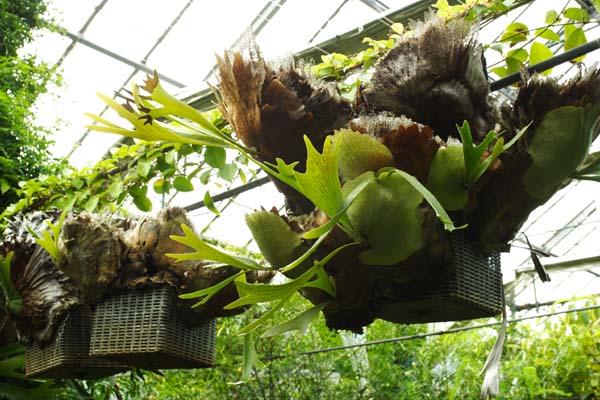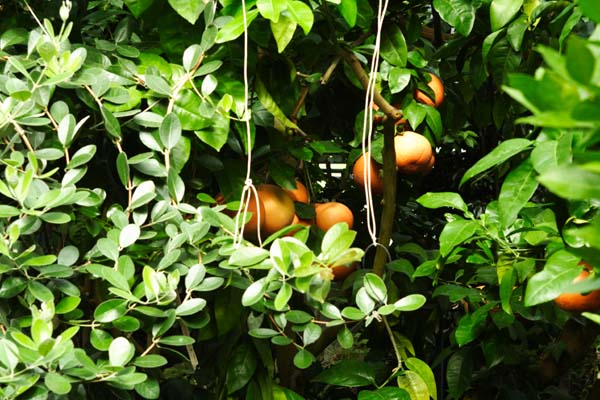Most of all because of high contrast, even in the absence of the direct sunlight.
F8, 1/60, ISO100 (too low, I didn't notice ...)
The epiphyte elkhorn fern Platycerium bifurcatum yesterday in Warsaw botanical garden in Powsin.
So it seems that using the flash is necessary sometimes. But on the other hand maybe such images with shadows look more naturally ?
And for example depth of field should not be not to high because of large number of details in the background.
F16, 0.3, ISO100
F2.8, 1/100, ISO100
Fuchsia 'Ginger' in the same greenhouse.
Obviously tripod is necessary. Probably white ballance is also critical, because of green light everywhere. Do anyone has experience in doing such pictures ?
Actually would be better do not enter the greenhouse because of moisture dangerous to the equipment.
 Helpful Posts: 0
Helpful Posts: 0
Results 1 to 9 of 9
-
6th September 2013, 12:08 PM #1
Photographing plants in the greenhouse or jungle is not so easy
Last edited by darekk; 6th September 2013 at 12:20 PM.
-
7th September 2013, 01:28 AM #2

- Join Date
- Sep 2013
- Location
- Kingsland, GA
- Posts
- 13
Re: Photographing plants in the greenhouse or jungle is not so easy
Whenever there are two things in the shot that have different darkness value, or are not a middle toned, or are getting different amounts of light then your camera's auto metering modes are just plain going to have a hard time.
Next time you shot in a situation like this put the camera in exposure mode in Manual (M on dial) and the metering mode to Spot (Dot instead of square). Point the circle in the view finder at what the picture is about. Then dial shutter speed, aperture or ISO towards the direction to get the Exposure Mark the value that best represents what you want to do with that subject. The Exposure Mark is the little pointer that goes between +4 and -4 with zero in the middle. It's doubles as the Exposure Compensation when in auto exposure modes.
This would have given you a more pleasing exposure for the first image and absolutely prevented the blown out flower in your second.
Hope that helps!
-
7th September 2013, 04:51 AM #3
-
7th September 2013, 06:14 PM #4

- Join Date
- Nov 2011
- Location
- Tulsa, OK
- Posts
- 468
- Real Name
- Larry Saideman
Re: Photographing plants in the greenhouse or jungle is not so easy
A very tough exposure situation. I would think that it is best not to blow highlights in flower images since white spots in the background can detract mightily. So, first, I would shoot raw. That way you can recover some highlights and lift some shadows without doing too much damage to the quality of the shot (if any). Second, I would avoid shooting up and letting so much contrast into the scene. No camera can capture that great a range of tones. Third, I would find pockets of shadow and use those pockets as background for my shots. Fourth, I would hope for a day with some clouds to diffuse the overall light. Maybe plan trips to the greenhouse with that in mind. Remember, it is all about using the quality of light to full advantage. Sometimes, we must surrender to the light and let it have its way.
-
8th September 2013, 08:08 AM #5
Re: Photographing plants in the greenhouse or jungle is not so easy
Here's a photograph I made in a greenhouse with a glass roof this past July just before noon on a sunny day, using a tripod, but no flash, essentially doing what Mark Treen suggested. I used the spot meter with the camera in manual mode. EXIF data included ISO 200, .6s at f/32, 100mm lens. The first image is the unprocessed (except to resize and change the original RAW to jpeg) image straight from the camera. The second image is the finished photograph after making adjustments in Lightroom and Photoshop.


I own a flash, but have never bothered to take it out of the box because I enjoy using available light. I hope these images are helpful.
-
8th September 2013, 12:22 PM #6
Re: Photographing plants in the greenhouse or jungle is not so easy
Great examples, Jeff. A lot of newbies will benefit by seeing these two examples. While you nailed the second one in your "dark room" (NOT darkroom), the original, unedited image is a classic snapshot image that drives me crazy! And, contrary to the view that darekk suggested (watch out for jungles and greenhouses), I think it applies to landscapes, architecture, people (not necessarily just portraits), and on and on.
Before the first time I visited France, 35 years ago, I looked at a LOT of coffee-table photography books trying to identify places I wanted to visit because of their "classic" photographs in such books. Of all the photographs I took, only one remains in my top photos collection: I described it in an earlier post, it was of the front of a bar with stacks of wet, red chairs, wet windows, and wet bricks because the owner had just washed everything down. The Sun was at a particularly low angle and coming straight down a street to the left behind me. The image could have been a perfectly ordinary snapshot, but I had the good sense to get in close and focus on the chairs, the windows, and the bricks. Because of the water drops on the windows, I was not reflected in the image nor were the storefronts behind me. Had either of those been present, I might coming home with a typical tourist shot! ;~( I'm much happier with what I got!
I'm jes' sayin'....
virginia
-
8th September 2013, 04:28 PM #7
Re: Photographing plants in the greenhouse or jungle is not so easy
Last edited by darekk; 8th September 2013 at 04:41 PM.
-
8th September 2013, 07:08 PM #8

- Join Date
- Sep 2013
- Location
- Kingsland, GA
- Posts
- 13
Re: Photographing plants in the greenhouse or jungle is not so easy
I don't agree with the concept of what you're saying but it's probably my fault. I didn't explain very well. In the process I discussed the only way anything will ever be over or under exposed is if you make that decision to have it be this way. You are composing with tones. You decide what zone (tone) the different parts of your picture will be. With the assumption that you have no flash and the background is limited (like the object is up high and can only be shot from one vantage point) this may mean there will be portions of your image in a different zone (tone) then you want in an ideal world. You have to make a decision based on what you know about composition for what is important. In the first image, with the Elkhorn fern properly exposed, the background will most likely be over exposed. You will lose detail there. This is ok. Having a portion of the image with no detail can sometimes add to your image. It's a decision you purposely make. That's the point of taking Manual control of exposure.
The second image is a easier example to see. You choose what zone (tone) you want the subject to be. Then move the spot meter around the rest of the shot and see what zones those areas will be. If having the subject at your chosen zone and the background at the zone they will fall will affectively tell the story you want to tell then take the picture. Otherwise look at how to work on fixing whatever issue you have. Recompose the shot, wait for a cloud, bounce light, get a flash, etc...
Your comment shows you think I'm saying use Spot metering and shoot so that the subject is at zero Exposure Mark. That's not what I'm saying. I'm saying take creative control of the tones of your composition.
-
8th September 2013, 07:19 PM #9

- Join Date
- Sep 2013
- Location
- Kingsland, GA
- Posts
- 13
Re: Photographing plants in the greenhouse or jungle is not so easy
This is a good example because look how far he could take this in post! Wow!
That's because he had more information to work with because he got a good starting exposure. Being in Manual and "spot metering around" takes the guessing out.
Keep in mind that in digital photography if the object is in the +1, +2, +3 area without highlights blown out you have more information to work with then if it was -1, -2, -3.
BTW for this image when Jeff held the spot meter over the white flower, in Manual exposure, he probably saw a +4 on the left flower and a +3 on the one on the right. He composed for tones. Spot metered on something white in Manual mode seeing +3 Exposure Mark is not the same thing as evaluative (or matrix) metering and being in AV or TV and setting +3 exposure compensation.
The beauty of this system is that you don't have to learn any of these words or grasp complicated concepts. Once you see it in action once it just clicks. When I teach my classes to photographers I start with this as the very first lesson. I then explain Aperture, shutter speed, composition, histograms, editing etc...





 Reply With Quote
Reply With Quote


